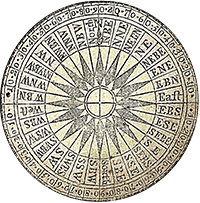Harrod served in the French and Indian War and became a scout and ranger. In 1774, he lead an expedition to survey the land to soldiers who served in the French and Indian War. He and 37 men traveled down the Monongahela and Ohio Rivers to the mouth of the Kentucky River, into what is now Mercer County, Kentucky. The men established the first pioneer settlement in Kentucky, Harrod’s Town.
In 1775, Harrod led a group of settlers to Harrodstown to stay. He successfully opposed Richard Henderson’s colonization schemes for the area. When Virginia created Kentucky County on December 31, 1776, Harrodstown was designated the county seat. In 1777, Harrod served as a justice in Kentucky County, and was elected to the Virginia House of Delegates in 1779. He also served as a trustee for the settlement that bore his name for many years.

James married Ann McDonald in 1776. The couple had one daughter in 1785. Throughout his life on the frontier, Harrod served in the militia, and became a Colonel in 1779.
In February 1792, he and two other men entered the wilderness of Kentucky to hunt for beaver. Harrod never returned.
Another theory stated Harrod abandoned his family and went to another part of the country. A legal deposition from Harrod’s sister claimed that Harrod came to live with her following his disappearance in Kentucky.
Another tradition holds that Harrod had been married in Pennsylvania before his pioneer days, and that he returned to his first family.

Another tradition holds that two pioneers from Kentucky who were being held captive by Indians near Detroit, Michigan saw a man enter the Indian camp. They claimed to recognize him, and addressed him as “Colonel Harrod.” Upon returning to Kentucky, the pair indicated that Harrod had intended to return to his family, but had not said when. Ann Harrod offered to pay the men to take her to Harrod’s location, but the felt that the trip was too dangerous.
In an interview with a historian half a century after Harrod’s disappearance, a man named Henry Wilson claimed that Harrod had told him that James felt like his wife had become too intimate with some of the other men in the town. Wilson claimed that Harrod told him “You will not see me here again,” and that years later, someone had claimed to have seen Harrod in the northern United States.
Some historians doubt Wilson’s account. In the will Harrod made prior to his disappearance, he left everything to his wife and daughter. Ann remarried in 1804 but was soon granted an annulment on the grounds that her James Harrod was still living. Some speculate Ann must have had contact with Harrod… while others speculate the claim enabled her to get out of a bad situation.
Researcher James Klotter wrote that James Harrod’s wife, daughter, and son-in-law believed that Harrod had been killed by one of his fellow hunters, a man named Bridges.
The family claimed that Harrod and his companions had not been hunting beaver, but were instead searching for a silver mine that a man named Jonathan Swift had claimed to have discovered years before.

According to Stoner’s account, the group had camped on the Three Forks of the Kentucky River near an area where Harrod had discovered several beaver. One morning, Stoner was making breakfast while Harrod and Bridges checked their traps. Suddenly, Bridges rushed back to the camp, claiming that he heard a shot from Harrod’s vicinity. When Harrod did not return, Bridges offered to look for him.
Bridges soon returned and claimed that he had seen signs of Indian activity in the woods, and stated Harrod must have been killed. Stoner wanted to look for Harrod, but Bridges insisted that it was too dangerous. Eventually, Stoner agreed. Soon after the expedition, Bridges went to Lexington where he sold some furs and some silver buttons engraved with the letter “H” at a local shop. The shopkeeper sent the buttons to Ann Harrod, who said they belonged to her husband.
Later, while searching the area where Harrod was last seen, some of Harrod’s friends found some bones in a cave. The bones were still tightly wrapped in sedge grass, which appeared to have been used to help transport the body to its present location. Some of the friends claimed that the bones were wearing Harrod’s shirt, and that the buttons were missing. Others claimed there was no shirt at all. Regardless, when the men returned, Bridges had fled the area.
Harrod’s family claimed that Bridges’ flight proved that Harrod’s friends had found Harrod’s body in the cave and feared that he would be implicated in his death.
Researcher John Kleber noted that when Ann applied for Harrod’s pension, she swore he had died in a hunting accident and that his clothes had been found in a nearby river.
Welcome to “Sharing the Stories of History with Tim Mann”!
Meet Timothy A. Mann, a passionate historian born and raised in the heart of Shelby County, Ohio where Tim’s roots run deep in the rich soil of American history. As the author of articles and books, including “Frontier Miscellany Concerning the Miami County Ohio Militia,” “Colonel John Mann, His Kith and Kin,” and “Frontier Militia – The War of 1812,” Tim’s literary contributions have enlightened and inspired countless history enthusiasts.
Join Tim Mann on a journey through time as he shares fascinating tales, untold stories, and hidden gems from the annals of history. Let’s delve into the past together and uncover the wonders that await in “Sharing the Stories of History with Tim Mann.”



